5 Different Ways To Get Page 1 Google Rankings
Getting your local business to get page 1 google rankings can be a game-changer. Securing a coveted spot on the first page not only boosts your visibility but also dramatically increases the chances of attracting new customers. In this blog post, we'll dive into five strategic ways that local businesses can optimize their online presence and skyrocket to the top of Google's rankings. Whether you're just starting out or looking to refine your existing SEO strategy, these tips are sure to give you a competitive edge.
#1. Ranking In Localized Organic Search Results
Local organic search results involves optimizing various elements to give your website the best chance to rank for products or services in a specific region. This approach is perfect for entities such as restaurants, local trades, or franchises.
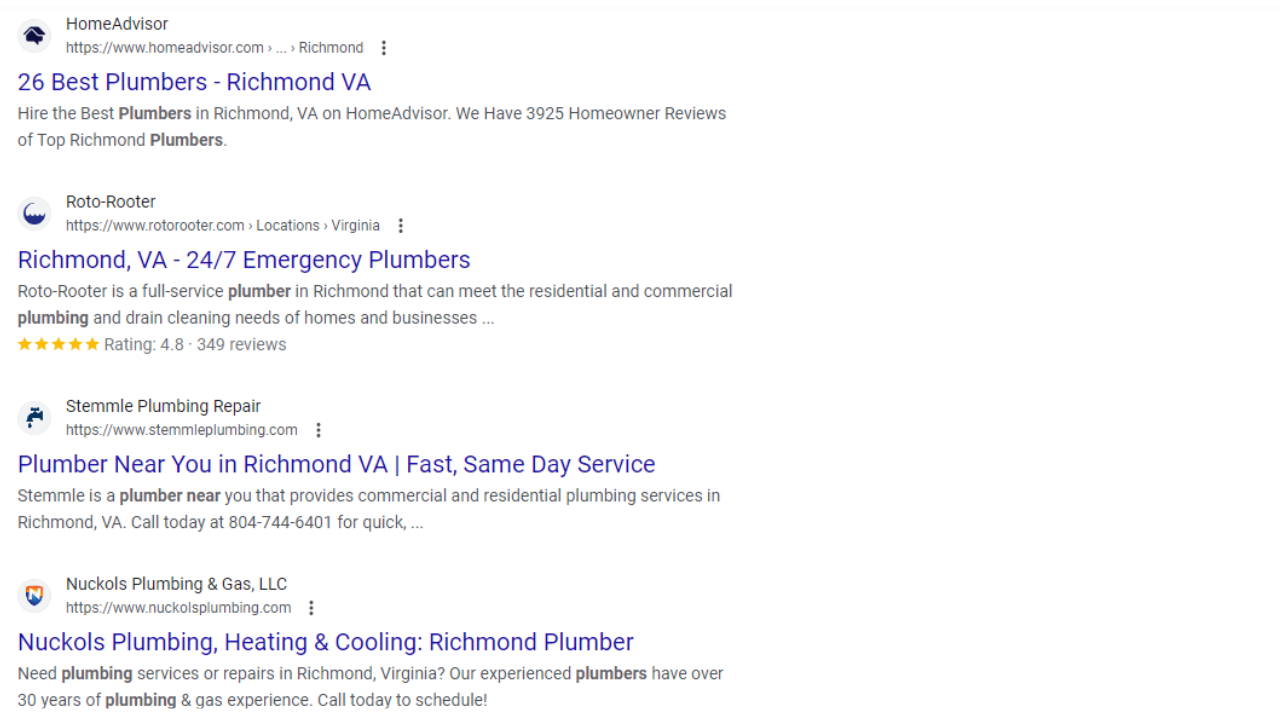
How to Get Page 1 Google Rankings in Local Organic Search Results
Optimizing your website for the local search algorithm is essential. To do this, you’ll need to:
- Create valuable content;
- Creating high-quality, relevant content for your website is a critical component of local SEO. Your content can take many forms, such as blog posts, videos, podcasts, animations, and more. It should be useful to your audience, so you’ll want to undertake some local keyword research first and have a clear understanding of what your audience needs from you.
- Great content will also help you to generate inbound links to your site, which is another local search ranking factor.
- Build internal links;
- Building internal links across your site is a simple yet powerful action, but one that’s easily neglected. Internal links are those that go from one part of your site to another. They help Google to better understand your website, making it easier for your site to be accurately represented in the local search results pages.
- When you’re adding internal links, make sure that each link points to a relevant page of your site with sensible anchor text.
- Have a mobile responsive design;
- A mobile responsive site is one that looks good and works perfectly across all screen sizes, including smaller cell phones.
- You can use Google’s Mobile-Friendly Test to check how responsive your site is on mobile.
- Optimize image and content metadata; and
- Using attractive images makes your website visually appealing. As well as choosing high-quality, relevant images, you should always optimize your images for search.
- Image optimization involves using keywords in the file name, as well as adding helpful alt text and a description—this is great for search discoverability and helps with web accessibility. You’ll also want to make sure your images are the optimum size and format to avoid slowing your website down.
- Content metadata helps to explain your site content to the search engines. This involves the use of attributes such as title tags and meta descriptions.
- It’s a wise idea to spend some time going through your website to make sure you’ve optimized your images and your content.
- Provide a positive user experience.
- Providing a positive user experience should be at the heart of everything you do on your website. This isn’t just beneficial to your local SEO campaign. If someone can’t find what they’re looking for on your site because the layout is confusing, for example, they’re almost certain to return to the search results and visit a competitor instead.
#2. Ranking In Google Local Finder
Google Local Finder is like your local business magnifying glass. It zeroes in on results from a specific small geographic zone, simplifying your hunt for nearby establishments. Intrinsically connected to Google Business Profiles, it usually springs into action when someone taps on a local pack result. It's all about getting you the local options, fast and easy.
Google Local Finder is a big player when it comes to local search for services, especially when you're in need of something specific, like "HVAC contractor in Richmond" or "HVAC contractor near me". It's a data powerhouse, aggregating info from various sources - we're talking Google and third-party reviews, Google Business Profiles, and individual business websites.
So when does Google Local Finder come into play? Right after you hit search and click on one of the local pack results, it pops right up!
What's it offering? A map loaded with multiple local business listings, each meticulously selected and presented with all the necessary information for you to evaluate and make an informed decision.
In a nutshell, it's like your personal guide to local HVAC contractors, all available at your fingertips.
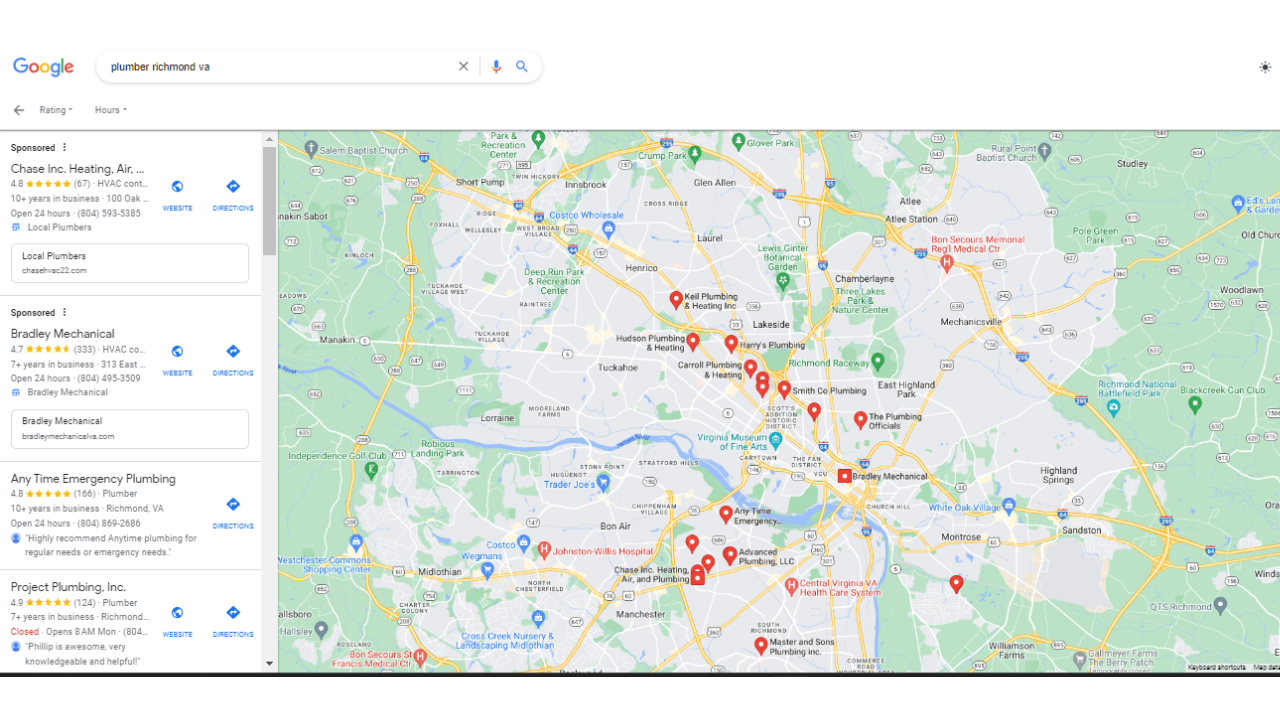
How to Get Page 1 Google Rankings in Google Local Finder
Given that Local Finder is so tightly woven with Google's 'standard' ranking criteria, your usual local SEO tricks are your ticket to better visibility here.
1.Give Your Google Business Profile Attention: The data you hand over to Google is pivotal to where you'll land in the search results. Make sure your Google Business Profile is in tip-top shape, with the right category, a detailed 'about' section, and spot-on NAPs and Q&As.
2. Focus on SEO: As we pointed out, usual local SEO cues are going to shape your position in Local Finder:
- Google Business Profile cues: Choosing additional categories, using keywords in reviews, and review frequency all matter. GBP cues are crucial for local SEO, so it's worth your while to get your listing just right.
- Review cues: Urge your customers or visitors to leave a review, and address any negative feedback pronto. Ratings count, so the more four and five-star reviews you can bag, the better.
- Citation cues: Citations are another key to being found in Google local searches. Aim for top-notch, credible, and authoritative citations. Make sure your citation profile is consistent because any mix-ups can water down trust.
- On-page cues: Local on-page SEO can lift your Local Finder ranks, so do a local SEO checkup and look for areas to improve.
- Link cues: Link cues, including anchor text, linking domain authority, link quantity, and link position, are vital in pushing your Local Finder standing up.
3. Crafting a Digital First Impression That Sticks: Think about the first impression you want to make digitally, and plan how to get there. Not only will this get you seen, but it will also get folks clicking on your listing, and, with any luck, turning them into customers. Here's what you can do:
- Enable GBP Messaging
- Sprinkle keywords in GBP Products
- Use keywords in Google Posts
- Add an Appointment URL
- Regularly update Google Posts
#3. Ranking in Google Maps
Google Maps is all about casting a wider net when it comes to search results, and it doesn't hone in on a narrow geographic area as much. That's because it started out as a mapping tool—a service designed to help you plot your route and spot things like gas stations, hotels, and eateries along the way.
Google Maps, just like Local Finder, gets its ranking juice from Google Business Profile (previously called Google My Business) data. When it's deciding which businesses to rank where, Google weighs factors like relevance, how close the business is to the person searching, and how well-known it is.
While Maps might look a lot like Local Finder at first glance, the key difference is the scope. Maps generally shows results over a much broader geographical area by default.
Maps is a favorite during mobile searches (voice searches included), given that Google Maps comes pre-installed on all Android phones and tablets. You can also find it through the 'Maps' tab on desktop searches.
Users who fire up Maps are usually in 'discovery' mode—they're exploring an area, plotting a route, or seeking out a landmark without a particular set of business listings in mind.
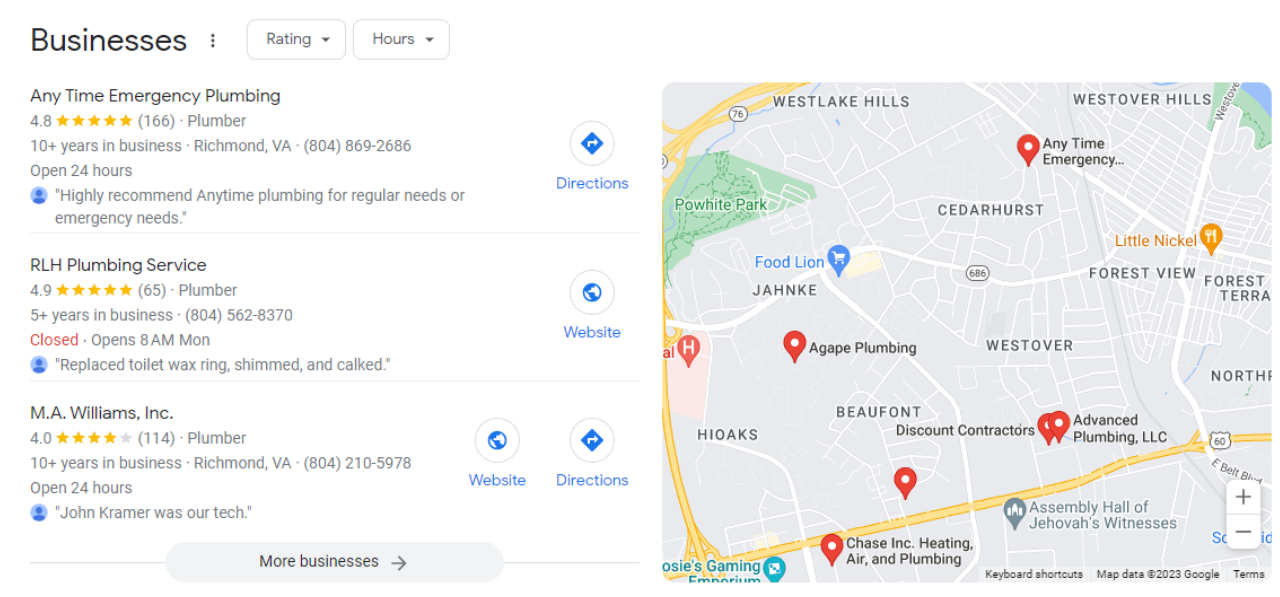
How to to Get Page 1 Google Rankings in Google Maps
Contrary to Google Local Finder, Google Maps functions as a standalone service, with no direct integration with search.
Securing a solid ranking on Google Maps relies heavily on the core principles of local SEO, namely relevance, proximity, and prominence, possibly even more than other platforms.
To elevate these crucial signals in Google Maps, you might want to consider implementing the following strategies.
1.Relevance: Users of Maps want to ensure that your business aligns with their specific needs. Enhance relevance by integrating suitable attribute icons, such as 'women-led' or 'Black-owned,' which show up in Maps results but not in Local Finder. Furthermore, eliminate duplicate listings that might present inconsistent or incorrect details.
2. Proximity: Users of Maps want assurance that your business is situated near their search area. Incorporate a local telephone number, including the area code, and embed a Google Map on your website. Both tactics confirm your location and offer users confidence that your business is situated where you claim it is.
3. Prominence: Prominence indicates high visibility – Maps users want to confirm that a business is active and legitimate. Maintain a consistent online presence and frequent posting as a starting point. Keep your business hours up-to-date, upload new product images, and think about launching a virtual tour.
Beyond Google, pursue local media features, establish links from local sources, stay active on social media, and consider writing thought-leadership articles or contributing by-lined pieces.
#4. Ranking in Google Local Services Ads
Local Services Ads, often referred to as Google Local Services Ads, are pay-per-lead advertisements that show up at the top of search results, above organic listings and regular Google Ads. For inclusion, a business must undergo a verification process that includes background checks, license verifications, and insurance validations. These checks can differ based on the type of business and its location.
This is what Local Services Ads might appear like in desktop search results:
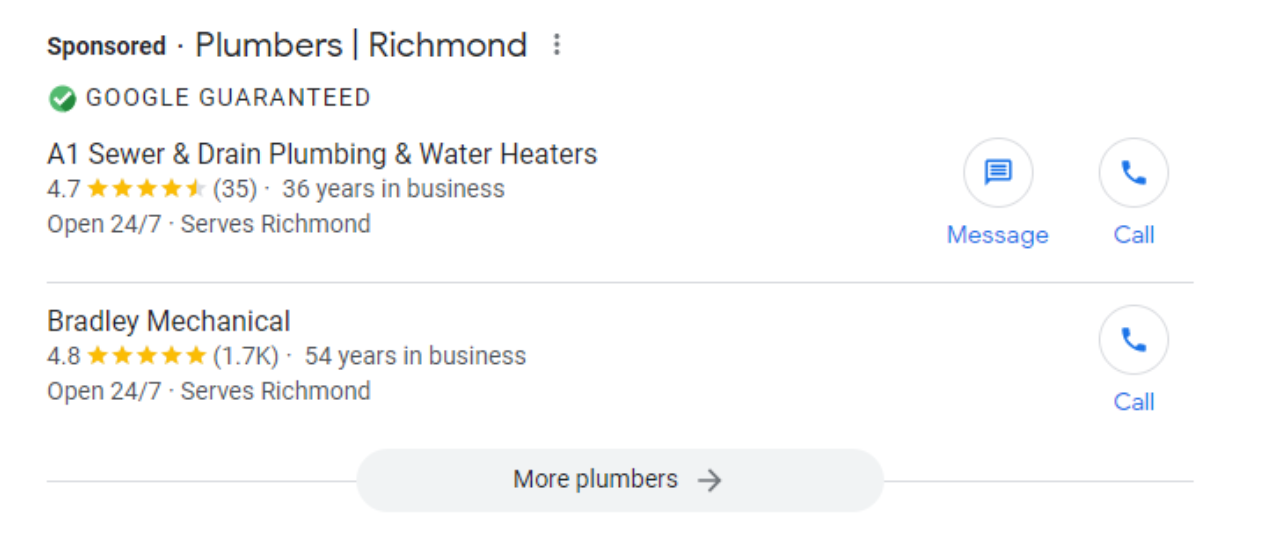
How to Rank in Local Services Ads (LSAs)
To navigate this landscape effectively and secure a coveted spot in the LSAs pack, you need to understand the key factors that influence your rankings. Here, we break down the crucial elements that can make or break your success in the world of Local Services Ads.
1. Number of Reviews - Your Reputation Matters: Star ratings and the quantity of reviews wield significant influence on your ranking within Local Services Ads. Businesses with higher star ratings and a larger volume of reviews tend to shine brighter in this competitive arena. It's a simple equation: better reviews equal more bookings.
2. Responsiveness to Leads - The Speedy Gets Ahead: Your ad's effectiveness in generating leads hinges on various factors, with responsiveness playing a pivotal role. Responsiveness extends beyond just answering inquiries and requests; it's about being prompt and attentive. Missed calls can cast a shadow on your responsiveness score.
3. Hours of Operation - Transparency Matters: Your provided business hours are crucial in giving potential customers a clear picture of when you're available. Accurate hours not only set expectations but also increase the likelihood of converting leads. However, marking your business as "temporarily closed" will affect your rankings and hide your Google Guaranteed badge.
4. Proximity to Searcher's Location - Location is King: Relevance is the name of the game when it comes to LSA rankings. How close you are to a potential customer's location, the services you offer, your business bio, and the reviews you've amassed all play a part. Much like Google My Business, LSAs thrive on proximity to the user. The closer you are, the higher your chances of being Google's chosen answer.
5. Services Offered - Tailoring Your Offerings: Defining the services you wish to advertise is vital. LSAs allow you to select services from a predefined list relevant to your business category. When users search for services aligned with your choices, your ads become eligible to appear. Additionally, your ad can show up for general category searches if you offer common services within your category.
Understanding and optimizing these factors can be the key to unlocking top rankings and securing a steady stream of leads. Mastering LSAs requires a strategic approach that blends stellar customer service with meticulous attention to detail.
#5. Ranking in Google Pay Pay Click Ads
One of the biggest advantages of PPC campaigns is how quickly they generate results. Whether you want more brand visibility, leads, or sales, a pay-per-click ad will deliver the results faster than SEO can. Therefore you can use PPC to get the quick results
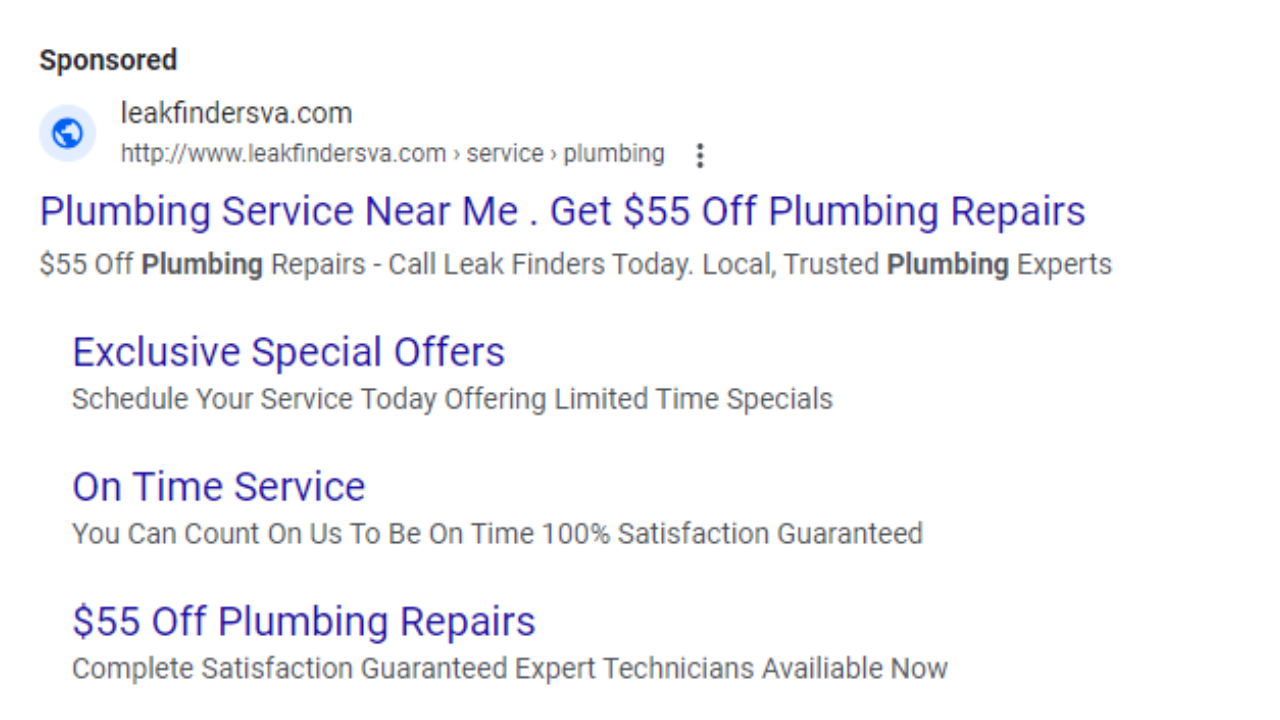
How to Rank in Google Ads Pay Per Click (PPC)
For any AdWords account, the key to a successful campaign is relevancy. Simply put, the more relevant your product/service is to the user’s search query, the better your ROI (for the AdWords geeks, I’ll leave out any discussion on quality score – for now!).
For local businesses, the immediate priority is to target the most relevant users – those that are looking for your service in your area.
In AdWords, there are two key ways of targeting locations in AdWords:
- Geo-Targeting (based on IP Addresses)
- Keyword Targeting (using a keyword modifier)
Several businesses choose one targeting method over the other, such as focusing either on nationwide searches for "Plumbers in Richmond, VA" or local searches in Richmond for "Plumbers".
Smart owners understand that utilizing both targeting strategies can help them connect with the most pertinent users, ultimately optimizing their return on investment (ROI) – and for good reason. If a user is physically in your area and searching for your service in that specific location, they are your most relevant potential customer.
To extend the example, the advertiser's principal focus should be on local searches in Richmond for "Richmond Plumbers".
Get in Touch with Your Local SEO Marketing Expert at Indispensable Marketing
Are you a well-established local business in Richmond VA looking to crack the code of Google's local search algorithm? If your goal is to get page 1 google rankings and score new customers, we are your go-to partner. We specialize in installing a local marketing process, offering a comprehensive approach to marketing services to help you succeed.
Whether you're seeking marketing strategy consulting or monthly internet marketing services specifically designed for business, we've got you covered. Contact us today to learn more and take your marketing to the next level.




